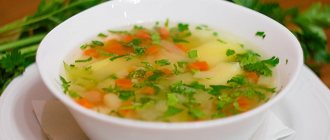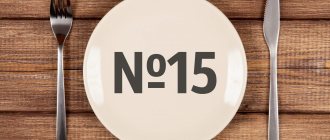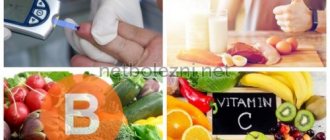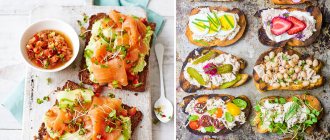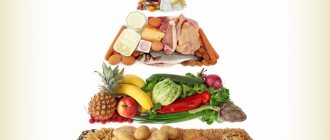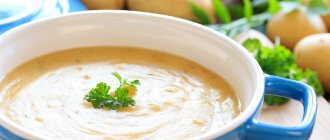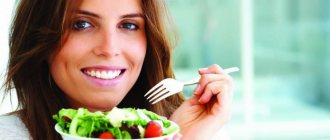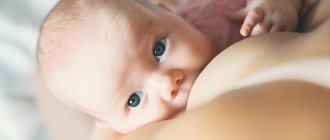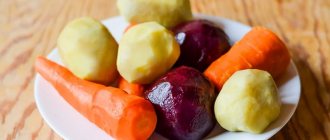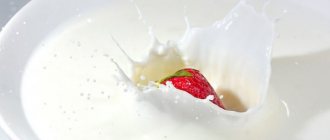11/27/2019 Article
- general characteristics
- Table "Do's and Don'ts"
- Menu for the week
The “11 table” diet is designed to help an organism weakened by illness cope with infectious and other diseases and quickly restore strength after illness.
Indications for use of the diet:
- mild exacerbation or completion of treatment for tuberculosis of the lungs, bones, joints and lymphatic system;
- for patients with exhaustion of the body after severe infectious diseases, serious injuries and operations;
- patients after lobar pneumonia and people suffering from anemia with low body weight.
The main goals of nutrition are to increase hemoglobin levels, strengthen the immune system, compensate for the deficiency of biologically active nutrients and vitamins, and also increase the body's resistance to infections.
General rules
Diet Table No. 11 is prescribed for diseases that are accompanied by reduced nutrition and general exhaustion (primarily tuberculosis ). The purpose of its purpose is to fully meet the need for protein, fat, vitamins , carbohydrates, increase and strengthen the body's defenses during recovery, enhance reparative processes and increase resistance to infections.
In this regard, this is a physiologically complete diet of high calorie content, in which the content of proteins (at the expense of animals), carbohydrates and fats, minerals and vitamins is increased. Chemical and mechanical irritants of the stomach and bile ducts are limited in the diet. 11 dietary table differs in the main points:
- Protein content 120 g (most animal), fat 110 g, carbohydrates 350-500 g.
- Enriched with vitamins B , C and A , and minerals (vegetables, fruits, rosehip infusion), dietary fiber, calcium (large amounts of dairy products).
- Calorie content - 3000-3500 kcal.
- Rich in dishes that improve appetite.
- You can consume the usual amount of salt (up to 15 g per day). It is limited only in case of exudative tuberculosis (6–8 g) and in severe cases (3–5 g) with a simultaneous reduction in fluid intake. This diet promotes diuresis and reduces inflammation.
- If the patient has diabetes mellitus, simple carbohydrates (sugar, sweets, confectionery) are excluded.
- With iron deficiency anemia, the amount of protein consumed is further increased to 140 g, since it stimulates the absorption of iron from food and the amount of fat is reduced to 80–90 g, which, on the contrary, impede the absorption of iron.
- Lean meat and poultry are recommended.
- Dishes are prepared stewed, boiled and baked. They can be served pureed or not - it depends on the patient’s health condition.
- Liquid is allowed up to 1.5–2 liters.
- Fractional meals are provided 4–6 times a day.
Due to the fact that in patients with tuberculosis proteins break down faster than in healthy people, more protein foods are included in the diet. At the same time, proteins must be easily and completely digested, which is why it is envisaged to consume all kinds of dairy products. In second place is lean meat and less desirable sources of protein are prepared meats and fatty meats/poultry. The same applies to fats: vegetable oils, butter and fish oil are recommended, but cooking fats, pork and lamb are not recommended.
The diet must include calcium and phosphorus. These substances are found in cauliflower, milk, cottage cheese, butter, cheese, kefir, sour cream, tomatoes, and figs. It should be noted that in milk these elements are in the required proportions.
A few words about vitamins . Taking anti-tuberculosis drugs significantly affects the metabolism of vitamins, and vitamin deficiencies . Knowing which foods they predominate in, it is imperative to include them in the patient’s diet. A patient with tuberculosis should receive 2 times more vitamin C Sources of this vitamin are: lemons, oranges, kiwi, tangerines, strawberries, black currants, gooseberries, cabbage, bell peppers, onions. Vitamin B1 is involved in carbohydrate metabolism and must be supplied daily with food, since it is not synthesized in the body.
It is present in large quantities in rice, brewer's yeast, wheat, sprouted rye grains, legumes, beef, kidneys, liver, and egg yolk. Vitamin B2 is contained in sunflower, cottonseed, corn and soybean oils, as well as sprouted wheat grains. Sources of vitamin B3 are nuts, brewer's yeast, legumes, grains, mushrooms, liver, potatoes, beef, pork, herring, eggs. Vitamin B6 is also an important ingredient in the diet of patients, since it is involved in protein metabolism. Contained in liver, kidneys, meat, cod, corn, legumes.
vitamin PP : brown rice, yeast, wheat germ, salmon, liver, shrimp. Vitamin B12 stimulates protein synthesis and is very important for patients. Contained in fish, beef and pork liver. Vitamin A is rich in: animal liver, egg yolks and butter, and carotenes (provitamins of vitamin A ) are formed in carrots, lettuce, fresh and dried apricots. Sources of vitamin E are cereal sprouts, sunflower, cottonseed, peanut, corn, soybean oils, meat, eggs, and milk.
Thus, therapeutic nutrition for this disease is the main factor aimed at correcting metabolism.
Consequences of not following the diet
The consequences of iron deficiency anemia include progression of the disease. Very low hemoglobin can cause:
- myodystrophy;
- atrophy of the mucous membranes of the digestive tract, genital organs and respiratory system.
In addition, low hemoglobin levels affect the cardiovascular system and lead to the development of pathological conditions. We should not forget about the weakening of the immune system, which is fraught with the occurrence of various infectious diseases.
Varieties
11 The diet has several options that take into account the localization of the tuberculosis process and its nature, as well as the presence of complications and concomitant diseases of the digestive system.
Option #1
Indicated for patients with reduced body reactivity, weakness, fever, and with a sluggish course of the disease. It has a slightly reduced content of proteins, fats and carbohydrates. The culinary preparation is the same, eating 5-6 times a day.
Option No. 2
Prescribed during periods of exacerbation, with severe inflammatory phenomena with tissue breakdown, high fever and exhaustion. The diet has an increased energy value and chemical composition, as with the main diet. The difference is that the food is prepared pureed and meals are eaten every 2–3 hours. Due to severe intoxication, an increased amount of ascorbic acid , various drinks (raw juices, rosehip decoction), vegetables and fruits are recommended.
Option #3
Recommended for exudative processes, therefore food is prepared without salt, and liquid is limited to 900–1000 ml. The chemical composition differs slightly from the main table.
Table No. 11o
Indicated for patients with burn disease. This is a diet with a high protein content (110–120 g) and adequately compensates for the protein and energy needs of the patient with superficial burns of a small area (10–20% of the body surface). Salt is limited in it (up to 6–8 g/day), meals are fractional. Dishes are prepared in stewed, boiled and mashed form, which provides chemical and mechanical sparing of the stomach. Liquid is allowed in quantities of 1.5–2 liters.
Authorized Products
The diet includes a variety of foods and dishes that stimulate appetite and are rich in extractive substances (broths, spices, but in moderation). Food should be tasty, have a pleasant smell and appetizing appearance (decorating dishes, adding fresh herbs to them). It is advisable that the main courses be preceded by appetizers in the form of vegetable salads with plenty of green onions, parsley, dill and the addition of vegetable oil.
Any bread according to the patient’s preferences is allowed: rye, wheat, grain. Baked goods and flour products are allowed. You can prepare any soups, excluding only fatty broths based on lamb and fatty pork. For first courses, you can offer (at the patient’s request) onions and garlic, which also stimulate the appetite.
Lean meat and chicken are served in any form: boiled, fried, baked and stewed. Moreover, fried and baked foods stimulate the appetite more. Liver and dishes made from it, as well as meat products, are also recommended. Fish can be of any variety, and its processing can also be varied. You can eat herring, canned food and fish roe as snacks. Sauces for meat and fish dishes and salad dressings should not be too spicy or fatty.
The side dish is prepared from any cereals, which need to be alternated in order to maximize the variety of the diet and enrich it with microelements. Cereals are used for milk porridges, casseroles and puddings. All pasta, any vegetables and legumes can be used as side dishes. Culinary processing allows you to prepare different dishes - stews, stewed vegetables, vegetable purees.
Any dairy products are allowed without restrictions: milk and milk drinks, kefir, ayran, kumiss, yogurt, cheeses, cottage cheese and dishes made from it. It depends on the patient's preferences. Fresh fruits can be consumed in their natural form and in the form of fruit salads, desserts, fruit drinks, juices, compotes or jelly. A decoction of rose hips, herbal decoctions with honey and lemon are useful. It is allowed to eat preserves, jams, marshmallows, marmalade, and marshmallows.
Table of permitted products
| Proteins, g | Fats, g | Carbohydrates, g | Calories, kcal | |
Vegetables and greens | ||||
| spicy vegetables | 2,8 | 0,5 | 5,3 | 36 |
| zucchini | 0,6 | 0,3 | 4,6 | 24 |
| cabbage | 1,8 | 0,1 | 4,7 | 27 |
| sauerkraut | 1,8 | 0,1 | 4,4 | 19 |
| bulb onions | 1,4 | 0,0 | 10,4 | 41 |
| carrot | 1,3 | 0,1 | 6,9 | 32 |
| canned cucumbers | 2,8 | 0,0 | 1,3 | 16 |
| pickles | 0,8 | 0,1 | 1,7 | 11 |
| beet | 1,5 | 0,1 | 8,8 | 40 |
| canned tomatoes | 1,1 | 0,1 | 3,5 | 20 |
| pumpkin | 1,3 | 0,3 | 7,7 | 28 |
| garlic | 6,5 | 0,5 | 29,9 | 143 |
Fruits | ||||
| apricots | 0,9 | 0,1 | 10,8 | 41 |
| oranges | 0,9 | 0,2 | 8,1 | 36 |
| watermelon | 0,6 | 0,1 | 5,8 | 25 |
| bananas | 1,5 | 0,2 | 21,8 | 95 |
| pears | 0,4 | 0,3 | 10,9 | 42 |
| melon | 0,6 | 0,3 | 7,4 | 33 |
| figs | 0,7 | 0,2 | 13,7 | 49 |
| lemons | 0,9 | 0,1 | 3,0 | 16 |
| tangerines | 0,8 | 0,2 | 7,5 | 33 |
| plums | 0,8 | 0,3 | 9,6 | 42 |
| apples | 0,4 | 0,4 | 9,8 | 47 |
Berries | ||||
| grape | 0,6 | 0,2 | 16,8 | 65 |
| strawberry | 0,8 | 0,4 | 7,5 | 41 |
| cranberry | 0,5 | 0,0 | 6,8 | 26 |
Mushrooms | ||||
| mushrooms | 3,5 | 2,0 | 2,5 | 30 |
| marinated mushrooms | 2,2 | 0,4 | 0,0 | 20 |
Nuts and dried fruits | ||||
| raisin | 2,9 | 0,6 | 66,0 | 264 |
| dried apricots | 5,2 | 0,3 | 51,0 | 215 |
| dried apricots | 5,0 | 0,4 | 50,6 | 213 |
| dates | 2,5 | 0,5 | 69,2 | 274 |
Cereals and porridges | ||||
| buckwheat (kernel) | 12,6 | 3,3 | 62,1 | 313 |
| cereals | 11,9 | 7,2 | 69,3 | 366 |
| corn grits | 8,3 | 1,2 | 75,0 | 337 |
| pearl barley | 9,3 | 1,1 | 73,7 | 320 |
| millet cereal | 11,5 | 3,3 | 69,3 | 348 |
| white rice | 6,7 | 0,7 | 78,9 | 344 |
Confectionery | ||||
| jam | 0,3 | 0,2 | 63,0 | 263 |
| jelly | 2,7 | 0,0 | 17,9 | 79 |
| marshmallows | 0,8 | 0,0 | 78,5 | 304 |
| candies | 4,3 | 19,8 | 67,5 | 453 |
| fruit and berry marmalade | 0,4 | 0,0 | 76,6 | 293 |
| paste | 0,5 | 0,0 | 80,8 | 310 |
| cookie | 7,5 | 11,8 | 74,9 | 417 |
| cake | 3,8 | 22,6 | 47,0 | 397 |
Chocolate | ||||
| chocolate | 5,4 | 35,3 | 56,5 | 544 |
Raw materials and seasonings | ||||
| honey | 0,8 | 0,0 | 81,5 | 329 |
| sugar | 0,0 | 0,0 | 99,7 | 398 |
Dairy | ||||
| milk | 3,2 | 3,6 | 4,8 | 64 |
| kefir | 3,4 | 2,0 | 4,7 | 51 |
| cream | 2,8 | 20,0 | 3,7 | 205 |
| sour cream | 2,8 | 20,0 | 3,2 | 206 |
| curdled milk | 2,9 | 2,5 | 4,1 | 53 |
| acidophilus | 2,8 | 3,2 | 3,8 | 57 |
| yogurt | 4,3 | 2,0 | 6,2 | 60 |
Cheeses and cottage cheese | ||||
| cottage cheese | 17,2 | 5,0 | 1,8 | 121 |
Meat products | ||||
| beef | 18,9 | 19,4 | 0,0 | 187 |
| veal | 19,7 | 1,2 | 0,0 | 90 |
| rabbit | 21,0 | 8,0 | 0,0 | 156 |
Bird | ||||
| chicken | 16,0 | 14,0 | 0,0 | 190 |
| turkey | 19,2 | 0,7 | 0,0 | 84 |
Eggs | ||||
| chicken eggs | 12,7 | 10,9 | 0,7 | 157 |
Fish and seafood | ||||
| black caviar | 28,0 | 9,7 | 0,0 | 203 |
| salmon caviar granular | 32,0 | 15,0 | 0,0 | 263 |
| punched pollock caviar | 28,4 | 1,9 | 0,0 | 131 |
| canned fish | 17,5 | 2,0 | 0,0 | 88 |
Oils and fats | ||||
| peasant unsalted butter | 1,0 | 72,5 | 1,4 | 662 |
| corn oil | 0,0 | 99,9 | 0,0 | 899 |
| olive oil | 0,0 | 99,8 | 0,0 | 898 |
| sunflower oil | 0,0 | 99,9 | 0,0 | 899 |
Non-alcoholic drinks | ||||
| mineral water | 0,0 | 0,0 | 0,0 | — |
| coffee | 0,2 | 0,0 | 0,3 | 2 |
| lingonberry juice | 0,1 | 0,0 | 10,7 | 41 |
| green tea | 0,0 | 0,0 | 0,0 | — |
| black tea | 20,0 | 5,1 | 6,9 | 152 |
Juices and compotes | ||||
| apricot juice | 0,9 | 0,1 | 9,0 | 38 |
| carrot juice | 1,1 | 0,1 | 6,4 | 28 |
| pumpkin juice | 0,0 | 0,0 | 9,0 | 38 |
| * data is per 100 g of product | ||||
Dish recipes
To prepare delicious and healthy dishes, you can use the following recipes:
- Meat broth with eggs. To prepare, rinse 600 g of beef, add 2.5 liters of water and cook over medium heat. When the liquid boils, turn the heat to low and continue cooking the meat for 2 hours. During this time, peel and chop celery (200 g), 2 carrots, ginger (30 g), 1 onion. Vegetables are added after cooking the broth for half an hour. At this time, salt, pepper and bay leaf are added. Next, you need to pass the liquid through cheesecloth, chop the meat and add to the broth. Before serving, toss in the greens;
- Cauliflower soup. Remove skin and fat from 1 chicken leg, add water and cook for an hour over low heat. After 30 minutes of cooking, add the onion, chopped carrots, bay leaves and black pepper with salt. After another 10 minutes, add 2 chopped potatoes and after cooking, add 300 grams of cabbage. All that remains is to boil the soup until the cabbage is soft, after 10 minutes you can eat;
- Chops. Cut 600 grams of veal and beat off the pieces, add salt and pepper. Squeeze a clove of garlic into 2 tbsp. l. mayonnaise, add 3 tbsp. l. honey and 1 tbsp. l. mustard powder, mix the ingredients thoroughly and coat the meat with this mixture. Leave in the refrigerator for a day to marinate the veal. Fry in vegetable oil over low heat, avoid burning;
- Zrazy. Remove the crust from 100 grams of white bread, and pour the crumb with milk and water in equal parts. Grind 0.5 kg of beef in a meat grinder with 3 onions and add bread. Knead the minced meat thoroughly. Boil 2 eggs, chop them, chop the herbs and mix the ingredients, add salt and pepper. Make flat cakes from the minced meat, add an egg and herbs inside. Roll in breading and fry in oil.
There are many recipes that are suitable for diet table 11, so choosing a diet will not be difficult.
Fully or partially limited products
The list of excluded products is small:
- very fatty meats and poultry;
- cooking fat, lamb and beef fat;
- cakes with a lot of cream.
Table of prohibited products
| Proteins, g | Fats, g | Carbohydrates, g | Calories, kcal | |
| pastry cream | 0,2 | 26,0 | 16,5 | 300 |
| pork | 16,0 | 21,6 | 0,0 | 259 |
| duck | 16,5 | 61,2 | 0,0 | 346 |
| smoked duck | 19,0 | 28,4 | 0,0 | 337 |
| goose | 16,1 | 33,3 | 0,0 | 364 |
| animal fat | 0,0 | 99,7 | 0,0 | 897 |
| cooking fat | 0,0 | 99,7 | 0,0 | 897 |
| * data is per 100 g of product | ||||
Indications for use
Table 11 is prescribed for tuberculosis, but there are other indications. Among them are:
- Long-term course of serious illnesses and long recovery. For example, recovery from pneumonia.
- Severe exhaustion.
- Anemia (anemia).
- Leukemia.
- Reduced nutrition.
To understand how to eat properly, you will need to familiarize yourself with the list of allowed and prohibited foods in table 11. If the pancreas is not functioning properly, you can use the 5p diet for pancreatitis.
If a person has a history of chronic gastrointestinal diseases, diet table number 1 will help reduce the frequency of their exacerbation.
Menu (Power Mode)
Since Diet number 11 includes all foods, the menu can be varied. It is necessary to include foods in which all the substances necessary for the body are present in optimal proportions: fish, meat, eggs, dairy products, vegetables and fruits. The emphasis in the diet is on protein foods and it is important to maintain a protein minimum at the rate of 1.5-2 g per 1 kg of weight (on average 120-130 g). It must be remembered that the digestibility of animal proteins is 94%, and that of plant proteins (bread, cereals, legumes) is somewhat less - 74%.
Considering the vitamin composition of foods mentioned above, you should try to include them in your diet every day. The distribution of energy value should be as follows: breakfast 30%, lunch - 40%, dinner - 20%, before bed 10%. The intervals between meals are no more than 4 hours. For the whole day, the patient can have 400 g of bread (wheat + rye bread) and 20 g of sugar.
Option 1
| Breakfast |
|
| Lunch |
|
| Dinner |
|
| Afternoon snack |
|
| Dinner |
|
| For the night |
|
Option 2
| Breakfast |
|
| Lunch |
|
| Dinner |
|
| Afternoon snack |
|
| Dinner |
|
| For the night |
|
Reviews and results
This therapeutic food cannot be called monotonous and tasteless, since it is complete and all foods are allowed. It all depends only on the possibilities and desire to diversify it.
The diet contains an increased amount of protein - the patient receives protein foods 5 times a day (including kefir or milk at night). Reviews often contain messages from patients who have suffered severe pneumonia or surgery and who were prescribed this diet.
- “... After several operations for a burn, I lost a lot of weight (by 10 kg), had almost no appetite, and had severe weakness. Already in the hospital, the doctor said that to enhance healing, you need good nutrition - mainly protein. The hospital could not provide this, and my relatives brought me parcels every day (even red caviar, salmon and cod liver). After a month, I began to feel more energetic, and the weight was restored only after 5 months”;
- “... There was severe abscess pneumonia, they made a puncture twice, endless fillings through a bronchoscope, a lot of antibiotics were dropped. We even thought about tuberculosis at first. I suffered terribly and in the end I could barely stand on my feet from weakness and loss of strength, but I didn’t want to eat anything. She started with intravenous glucose and vitamins and began bringing high-calorie foods from home to add to hospital meals. At home I continued to eat heavily and only got out of it a month later.”

